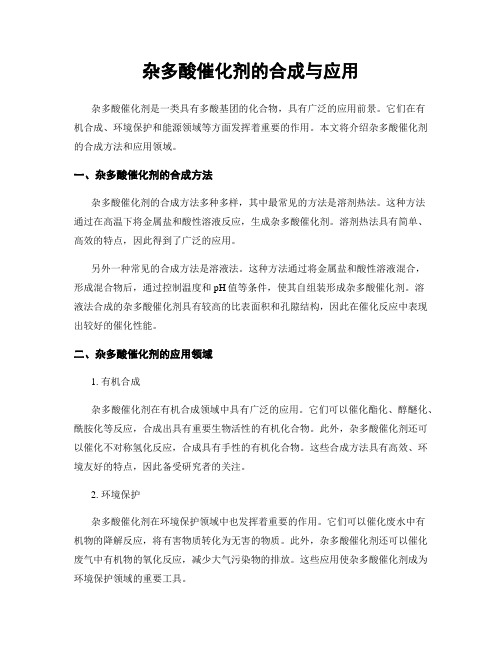杂多酸催化剂
杂多酸催化剂的合成与应用

杂多酸催化剂的合成与应用杂多酸催化剂是一类具有多酸基团的化合物,具有广泛的应用前景。
它们在有机合成、环境保护和能源领域等方面发挥着重要的作用。
本文将介绍杂多酸催化剂的合成方法和应用领域。
一、杂多酸催化剂的合成方法杂多酸催化剂的合成方法多种多样,其中最常见的方法是溶剂热法。
这种方法通过在高温下将金属盐和酸性溶液反应,生成杂多酸催化剂。
溶剂热法具有简单、高效的特点,因此得到了广泛的应用。
另外一种常见的合成方法是溶液法。
这种方法通过将金属盐和酸性溶液混合,形成混合物后,通过控制温度和pH值等条件,使其自组装形成杂多酸催化剂。
溶液法合成的杂多酸催化剂具有较高的比表面积和孔隙结构,因此在催化反应中表现出较好的催化性能。
二、杂多酸催化剂的应用领域1. 有机合成杂多酸催化剂在有机合成领域中具有广泛的应用。
它们可以催化酯化、醇醚化、酰胺化等反应,合成出具有重要生物活性的有机化合物。
此外,杂多酸催化剂还可以催化不对称氢化反应,合成具有手性的有机化合物。
这些合成方法具有高效、环境友好的特点,因此备受研究者的关注。
2. 环境保护杂多酸催化剂在环境保护领域中也发挥着重要的作用。
它们可以催化废水中有机物的降解反应,将有害物质转化为无害的物质。
此外,杂多酸催化剂还可以催化废气中有机物的氧化反应,减少大气污染物的排放。
这些应用使杂多酸催化剂成为环境保护领域的重要工具。
3. 能源领域杂多酸催化剂在能源领域中也有着广泛的应用。
它们可以催化生物质转化为生物燃料,提供可再生能源。
此外,杂多酸催化剂还可以催化氢气的产生和利用,促进氢能的开发和利用。
这些应用使杂多酸催化剂在能源领域中具有重要的地位。
总结:杂多酸催化剂作为一类具有多酸基团的化合物,具有广泛的应用前景。
它们的合成方法多种多样,其中溶剂热法和溶液法是常见的合成方法。
杂多酸催化剂在有机合成、环境保护和能源领域等方面发挥着重要的作用。
它们可以催化合成具有重要生物活性的有机化合物,降解废水中的有机物,减少大气污染物的排放,提供可再生能源等。
杂多酸

摘要杂多酸(Heteropolyacid),也称多金属氧簇(Polyoxometalate),是一类由氧原子桥接金属原子形成的金属-氧簇化合物.杂多酸具有良好的催化性能,是高效的双功能催化剂,即有酸催化性能,又具有氧化还原催化性能.杂多酸结构稳定,可以用在均相或者非均相催化环境,也可作相转移催化剂,对环境无污染,是一类大有前途的绿色催化剂,它可用作以芳烃烷基化和脱烷基反应、酯化反应、脱水/化合反应、氧化还原反应以及开环、缩合、加成和醚化反应等。
因杂多酸独特的酸性、“准夜相”行为、多功能(酸、氧化、光电催化)等优点在催化研究领域中受到研究者们的广泛重视。
关键词:杂多酸;酸催化;氧化催化目录摘要 (1)1.前言 (3)1.1杂多酸催化剂的物性 (3)1.1.1初级结构和次级结构 (4)1.1.2热稳定性、含水量及比表面积 (4)1.1.3准液相性质 (5)1.2杂多酸化合物作为固体酸催化剂的主要优点 (5)2.杂多酸及其化合物在催化方面的应用 (6)2.1酸催化 (6)2.1.1酸性 (6)2.1.2均相酸催化 (6)2.1.3多相酸催化 (6)2.2氧化还原催化 (7)2.2.1氧化还原性 (7)2.2.2均相氧化催化 (7)2.2.3多相氧化催化 (7)2.3杂多酸的载体 (8)2.3.1载体的作用 (8)2.3.2载体的选择 (8)2.3.3主要的负载方法 (8)3.应用 (9)3.1在炼油技术中的应用 (9)3.2在化工中的应用 (9)3.3在精细化学品合成中的应用 (10)4.文献 (12)1.前言杂多酸(简称HPA)作为固体酸催化剂, 其强度远远高于通常的无机酸, 在过去20多年来一直受到催化领域的广泛重视。
杂多酸是由中心原子(杂原子)和配位体(多原子)通过氧原子配位桥联的一类多核配酸, 按其阴原子结构可分为Keggin、Slverton、Daw-son、WaughAnderson五种类型。
杂多酸催化剂上的酯化反应

汇报人: 日期:
contents
目录
• 杂多酸催化剂介绍 • 酯化反应原理 • 杂多酸催化剂在酯化反应中的应用 • 杂多酸催化剂的表征与优化 • 酯化反应的工艺流程与操作条件 • 研究展望与工业化前景
01
杂多酸催化剂介绍
杂多酸的组成和结构
杂多酸是一种由中心原子(P, B,Si等)和配位体(如O,S,
酯化反应的定义和化学过程
酯化反应定义
酯化反应是一种有机化学反应, 涉及羧酸与醇之间通过酯键形成 酯类化合物。
化学过程
羧酸与醇在催化剂的作用下,通 过脱水、脱醇等步骤生成酯类化 合物。这个过程需要一定的能量 ,如加热、加压等。
酯化反应的机理与动力学
机理
酯化反应的机理主要涉及亲核试剂(醇)对亲电子试剂(羧酸)的攻击,生成 酯类化合物和水。在这个过程中,催化剂可以降低反应活化能,加速反应速度 。
VS
详细描述
操作条件的优化包括温度、压力、搅拌速 度、反应时间等因素。通过实践和实验数 据的分析,可以找到最佳的操作条件,提 高催化剂活性和产物收率。
酯化反应的产物分离与后处理技术
总结词
产物分离与后处理是酯化反应的重要环节, 需要采用有效的技术手段。
详细描述
产物分离方面,通常采用蒸馏、萃取、过滤 等技术,根据产物的性质和要求选择合适的 方法。后处理方面,可以进行产品精制、提 纯、干燥等操作,以满足产品的质量要求。
元素分析
测定催化剂中各元素的含量, 如H、N、O等,以了解其化学
组成。
红外光谱
分析催化剂的官能团和化学结 构,如酸性基团、有机配体等 。
热分析
通过热重、差热分析等方法研 究催化剂的热稳定性及分解行 为。
杂多酸催化剂的研究进展与应用

杂多酸催化剂的研究进展与应用杂多酸催化剂是指由不同金属离子与氧原子或氮原子通过共价键或离子键相连而形成的离子配合物。
其独特的结构和性质赋予了杂多酸催化剂广泛的应用前景。
本文将就杂多酸催化剂的研究进展以及其在不同领域中的应用进行探讨。
一、杂多酸催化剂的研究进展杂多酸催化剂的研究可以追溯到早期的20世纪。
在过去的几十年里,人们对杂多酸催化剂的研究不断深入,并涌现出了许多重要的理论和实验成果。
以下是杂多酸催化剂研究的几个重要方面:1. 杂多酸催化剂的合成方法:通过改变金属离子的种类和配比,以及反应条件的控制,可以合成出不同结构和性能的杂多酸催化剂。
常见的合成方法包括溶剂热法、水热法、溶液沉淀法等。
2. 杂多酸催化剂的结构表征:采用X射线衍射、质谱、红外光谱等技术手段,可以对杂多酸催化剂的结构进行表征和分析。
这些表征方法的应用有助于我们深入理解催化机理和性质。
3. 杂多酸催化剂的催化性能研究:通过选择适当的催化反应体系,可以评价杂多酸催化剂的催化性能。
这些反应可以涉及有机合成、环境保护、能源转化等多个领域。
4. 杂多酸催化剂的催化机理研究:借助理论计算和实验技术,可以揭示杂多酸催化剂的催化机理。
这有助于我们深入了解催化过程,并指导催化剂的设计和合成。
5. 杂多酸催化剂的应用拓展:杂多酸催化剂不仅在有机合成领域有重要应用,还可以应用于环境污染治理、能源储存转化、电化学催化等方面。
这些应用拓展使得杂多酸催化剂研究具有广泛的应用前景。
二、杂多酸催化剂在不同领域中的应用1. 有机合成领域:杂多酸催化剂在有机合成反应中发挥着重要作用。
例如,研究者们利用杂多酸催化剂实现了多种有机反应的高效催化,如羧酸酯的酯化反应、羰基化合物的氧化反应等。
2. 环境保护领域:杂多酸催化剂对环境污染物的降解和转化具有良好的催化性能。
例如,杂多酸催化剂可以用于水处理领域中有机污染物的降解,具有高效、低成本、环保的特点。
3. 能源转化领域:杂多酸催化剂在能源转化领域中发挥着重要作用。
杂多酸催化剂合成

杂多酸催化剂合成杂多酸催化剂是一类具有多酸性质的化合物,在有机合成中被广泛应用。
它们能够催化多种反应,具有高效、环境友好等优点。
本文将介绍杂多酸催化剂的合成方法以及其在有机合成中的应用。
杂多酸催化剂的合成方法有多种途径,其中一种常用的方法是通过溶液法合成。
以钨酸为例,首先将钨酸溶解于适当的溶剂中,然后通过加入适量的还原剂,如亚硫酸钠,将钨酸还原成钨酸盐。
随后,将溶剂蒸发,得到钨酸盐的固体。
最后,将固体钨酸盐进行焙烧,得到杂多酸催化剂。
杂多酸催化剂具有很高的活性和选择性,在有机合成中有广泛的应用。
首先,杂多酸催化剂可以催化酯的酯交换反应。
在酯交换反应中,酯可以与醇发生反应,生成不同的酯。
这种反应在合成香精、医药和农药等领域中具有重要的应用价值。
杂多酸催化剂可以催化酮的氧化反应。
在酮的氧化反应中,酮可以与氧气发生反应,生成醛或羧酸。
这种反应在有机合成中常用于合成醛和羧酸化合物,具有重要的合成意义。
杂多酸催化剂还可以催化芳烃的烷基化反应。
在烷基化反应中,芳烃可以与醇或醚反应,生成相应的烷基化产物。
这种反应在有机合成中常用于合成具有特定结构的有机化合物,具有广泛的应用前景。
除了上述反应,杂多酸催化剂还可以催化酮的羟醛互变异构反应、烯烃的氧化反应、烯烃的环氧化反应等。
这些反应在有机合成中具有重要的地位,杂多酸催化剂的应用为这些反应提供了高效、环境友好的催化剂。
杂多酸催化剂是一类重要的催化剂,在有机合成中具有广泛的应用。
通过合成方法的不同,可以得到不同种类的杂多酸催化剂。
在有机合成中,杂多酸催化剂可以催化酯交换、酮氧化、芳烃烷基化等多种反应,具有高效、环境友好的特点。
随着科学技术的不断发展,杂多酸催化剂的合成方法和应用将会得到更多的研究和探索,为有机合成领域带来更多的机遇和挑战。
杂多酸催化剂上的酯化反应研究

杂多酸催化剂在酯化反应中的挑战
稳定性问题
杂多酸催化剂在某些条件下可能存在稳定性问题, 如酸碱度的变化和高温条件下的分解。
适用范围有限
杂多酸催化剂对于某些底物和反应条件可能存在适 用范围有限的问题,需要进一步优化。
生产成本较高
杂多酸催化剂的生产成本相对较高,限制了其广泛 应用。
未来在酯化反应中应用杂多酸催化剂的研究方向
03
杂多酸催化剂上的酯化反 应研究
杂多酸催化剂对酯Biblioteka 反应的影响酸强度杂多酸催化剂的酸强度对酯化反应具有重 要影响。一般来说,酸强度越高,催化活 性越大,但同时也可能导致副反应增加。
VS
配位效应
杂多酸催化剂的配位效应对酯化反应也有 影响。配位效应可以改变反应物的活性和 选择性,从而影响反应的速率和产物分布 。
发展趋势是进一步探索杂多酸催化剂的作用机制和反应机 理,开发新型的杂多酸催化剂,拓展其应用领域,实现更 加环保和高效的有机化学反应。
02
酯化反应的基本原理
酯化反应的定义与历程
酯化反应定义
酯化反应是一种有机化学反应,涉及羧酸与醇之间通过酯基的生成而进行的脱水反应。
酯化历程
在酯化反应中,羧酸首先与醇形成络合物,然后通过失去水分子形成酯基,最后生成的酯从络合物中释放出来 。
压力
对于气体参与的酯化反应,压力对反应的影响也是显著的 。通常需要加压来增加气体分子的浓度,从而促进反应。
催化剂
催化剂可以降低酯化反应的能垒,提供更多的活化能,并 加速反应速率。常用的催化剂包括杂多酸、酸性离子交换 树脂和固体酸等。
溶剂
溶剂的选择对酯化反应也有重要影响。合适的溶剂可以增 加反应物的溶解度,降低浓度梯度,并可能抑制副反应的 发生。
杂多酸催化剂

杂多酸的结构
1:12的keggin 型结构,通式为(XM12O40)n(X=P,Si Ge等)如PW12O403- , SiW12O403-等。
杂多酸的结构
2:18的 Dawson型结构通式为(X2M18O62)n (X=Mo W等M=P S等),可以看做是 keggin型的衍生物。
杂多酸的结构
L/O/G/O
杂多酸催化剂
1Leabharlann 杂多酸的概述 杂多酸的结构 杂多酸的催化类型
2
3
4
总结与展望
什么是杂多酸?
杂多酸也称多金属氧簇,是一类由氧原子桥接金 属原子形成的金属-氧簇化合物,杂多酸具有良好 的催化性能,是高效的双功能催化剂,即有酸催 化性能,又具有氧化还原催化性能,杂多酸结构 稳定,可以用在均相或者非均相催化环境,也可 以和相转移催化剂共同使用,杂多酸对环境无污 染,对设备腐蚀性小,是一类很有发展前途的绿 色催化剂。
负载杂多酸
Akihiro 等把[{ γ-SiW10O32( H2O )2}2( l-O)2]4作为催化剂用于Knovenagel 反应得到了96%的产 率( 图6) ,催化剂的缺位表现出Lewis 酸酸性,同 时H+表现出Brnsted 酸酸性。
负载杂多酸
Friedel-Crafts 反应是芳香烃烷基化酰基化的 重要反应,杂多酸对其有良好的催化效果, 对于去烷基化和异构化也有很好的催化效果。
负载杂多酸
虽然杂多酸催化剂在均相条件下表现出了比 传统无机酸更强的活性,但因其成本较高, 于是研究重点逐步转移到各种固载方法以及 可以方便回收重复使用的绿色化学方法上来。 经常使用的载体有: SiO2、介孔氧化铝、沸石、 分子、ZrO2、镁铝水滑、高分子聚合物等。
杂多酸催化剂在烷基化反应中的应用

01
02
03
选择合适载体
选用具有高比表面积和孔 容的载体,如活性炭、氧 化铝等,提高杂多酸催化 剂的分散度和活性。
掺杂改性
通过掺杂其他金属离子或 非金属元素,改变杂多酸 催化剂的结构和电子性质 ,从而提高其催化活性。
优化制备条件
调整制备过程中的温度、 时间、pH值等参数,使杂 多酸催化剂达到最佳的结 构和性能。
杂多酸催化剂在烷基化反应中 作用机制
杂多酸催化剂活性中心形成过程
活性中心形成
杂多酸催化剂的活性中心主要由 杂多阴离子、阳离子和结晶水构 成,其形成过程包括杂多酸的解
离和阳离子的配位。
杂多酸解离
杂多酸在水溶液中发生解离,生成 杂多阴离子和阳离子。杂多阴离子 具有较强的酸性,能够提供质子参 与烷基化反应。
06
工业应用前景展望与挑烷基化反应市场需求
预测烷基化反应市场需求增长趋势,分析杂多酸催化剂在其中的应 用潜力。
催化剂性能提升
预测杂多酸催化剂性能提升方向,包括活性、选择性、稳定性等方 面。
绿色化学发展
预测绿色化学发展趋势,分析杂多酸催化剂在烷基化反应中的环保优 势。
面临问题和挑战分析
催化剂制备成本
分析杂多酸催化剂制备成本高的原因,提出降低成本的方法和途 径。
反应条件优化
分析烷基化反应过程中反应条件对催化剂性能的影响,提出优化反 应条件的策略。
催化剂失活问题
探讨杂多酸催化剂在烷基化反应中失活的原因和机理,提出延长催 化剂寿命的方法。
发展趋势和策略建议
01
新型杂多酸催化剂研发
杂多酸催化剂表征技术
X射线衍射(XRD)
通过X射线衍射技术对杂多酸催化剂进行物相分析,确定其晶体结 构和组成。
- 1、下载文档前请自行甄别文档内容的完整性,平台不提供额外的编辑、内容补充、找答案等附加服务。
- 2、"仅部分预览"的文档,不可在线预览部分如存在完整性等问题,可反馈申请退款(可完整预览的文档不适用该条件!)。
- 3、如文档侵犯您的权益,请联系客服反馈,我们会尽快为您处理(人工客服工作时间:9:00-18:30)。
Heteropoly acids:a green and efficient heterogeneous Br ønsted acidic catalyst for the intermolecular hydroamination of olefinsLei Yang a ,Li-Wen Xu a,b,*,Chun-Gu Xia a,*aState Key Laboratory for Oxo Synthesis and Selective Oxidation,Lanzhou Institute of Chemical Physics,Chinese Academy of Sciences,and Graduate School of the Chinese Academy of Sciences,Lanzhou 730000,PR ChinabDepartment of Chemistry,National University of Singapore,3Science Drive 3,Singapore 117543,Republic of SingaporeReceived 8February 2008;revised 5March 2008;accepted 6March 2008Available online 10March 2008AbstractIntermolecular hydroamination of non-activated olefins with amides and benzyl carbamate proceeds efficiently in the presence of environmentally benign silicotungstic acid (HSiW)catalyst under mild conditions in air to afford addition products in good to excellent yields.Ó2008Elsevier Ltd.All rights reserved.Keywords:Heteropoly acids;Intermolecular hydroamination;Amides;OlefinsIn recent years,Keggin type heteropoly acids (HPAs)catalysts have received much attentions in both academic and industrial applications due to their unique properties,which offers several advantages in terms of catalytic perfor-mance,strong acidic,and redox site and selectivity to par-ticular reaction product by selective stabilization of reaction intermediate.1HPAs are non-corrosive,environ-mentally benign,and economically feasible solid acid cata-lysts compared to conventional homogeneous acids,such as H 2SO 4or TfOH.Furthermore,they can be reused and recycled easily in most cases after the reaction and hence they are regarded as green catalysts.As a consequence,a variety of synthetically useful transformations have been developed using HPAs as catalysts,such as oxidation of alcohols,2esterification,3Friedel–Crafts reactions,4Man-nich reactions,5cyanosilylation,6ring-opening of epox-ides,7and dehydration.8Hydroamination,the simple addition of an N–H bond across C–C unsaturated organic fragment,has attracted much attention in the past decades.Intermolecular hydro-amination of olefins is one of the most important and chal-lenging topics in this area.9Despite significant efforts that have been devoted into the intermolecular hydroamination of olefins with alkylamines and arylamines,only a few reports of the intermolecular hydroamination of non-acti-vated alkenes with weakly basic amine nucleophiles such as sulfonamides,carbamates,and carboxamides are known (Scheme 1).Recently,efficient platinum(II),10gold(I),11Cu(II),12Fe(III),13and other metal salts 14catalyzed hydroamina-tions of amides and carbamates were reported.Along with the metal catalysts,there also have been examples using metal-free catalysts for the hydroaminations of olefins and amides.15Although some notable progress has been made on the hydroamination reactions of alkenes with0040-4039/$-see front matter Ó2008Elsevier Ltd.All rights reserved.doi:10.1016/j.tetlet.2008.03.034*Corresponding authors.Tel.:+8609314968056;fax:+8609318277088(L.-W.X.).E-mail addresses:licpxulw@ (L.-W.Xu),cgxia@(C.-G.Xia).Available online at Tetrahedron Letters 49(2008)2882–2885amides in the past two years,there are also some draw-backs on the reported methods,such as using expensive and toxic metals,higher reaction temperature,large excess amounts of olefins,and tedious reaction procedures.Addi-tionally,most of the reported methods must be carried out under inert atmosphere.Therefore,the development of a novel,green,and simple catalyst for addition reactions of non-activated alkenes with sulfonamides,carboxamides and carbamates remains an intriguing challenge.Although silver-exchanged tungstophosphoric acid 16or using HPAs as acid additive 17have been examined for intermolecular hydroamination of alkynes with aromatic amines,to the best of our knowledge,there are no studies and reports of HPAs-catalyzed intermolecular hydroamin-ation of olefins with amides.In the present letter,we report an efficiently,easy operational,and reusable heteropoly acids catalyst for the intermolecular hydroamination of various olefins with both amides and carbamates.In order to study the feasibility of HPAs-catalyzed hydroamination of amides,hydroamination of cyclohexene with p -toluenesulfonamide (TsNH 2)was selected as a model reaction (Table 1).Under our reaction conditions,Table 1Hydroamination between toluenesulfonamide and cyclohexene under different reactionconditions+NH 2TsNHTscatalystEntry a CatalystSolvent Yield b (%)1H 3PW 12O 40Án H 2O DCE 632H 3PMo 12O 40Án H 2O DCE 823H 3SiW 12O 40Án H 2O DCE 954Na 3PMo 12O 40DCE NR 5(NH 4)3PW 12O 40DCE Trace 6Ag 3PW 12O 40DCE Trace 7H 2MoO 4DCE NR c 8NH 2SO 3HDCE NR c 9H 3SiW 12O 40Án H 2O CH 3CN Trace 10H 3SiW 12O 40Án H 2O n -Heptane 8611H 3SiW 12O 40Án H 2O CH 3Ph9212H 3SiW 12O 40Án H 2O1,2-Dioxane75aReaction conditions:cyclohexene (2mmol),NH 2Ts (1mmol),catalyst (100mg),solvent (2ml),85°C,18h,sealed tube,in air.bGC yield.cUsing 0.1mmol of solid acid as catalyst.Table 2Hydroamination of unactivated olefins with nitrogen nucleophiles 18R 12+NH 2RH 3SiW 12O 40·nH 2OsolventR 1R 2NHR Entry a OlefinNucleophile Time (h)/Temp (°C)Solvent ProductYield b (%)1NH 2Ts23/85DCENHTs782NH2Ts 18/85DCE NHTs913PhSO 2NH 218/85DCENHSO 2Ph544NH 2Ts24/45DCENHTs785NH 2Ts24/rtDCENHTs646ClNH 2Ts 24/45DCENHTsCl687NH 2Ts24/85DCENHTs88(continued on next page )L.Yang et al./Tetrahedron Letters 49(2008)2882–28852883among the HPAs tested,H3SiW12O40Án H2O was found to be the most efficient catalyst compared to H3PW12O40Án H2O and H3PMo12O40Án H2O.Solid acids such as NH2SO3H and H2MoO4could not furnish the desired products.No or only trace products were found when using the HPAs salts such as Na3PMo12O40, (NH4)3PW12O40,and Ag3PW12O40as ing H3SiW12O40Án H2O as catalyst,various solvents were then examined.Among the solvents examined,non-polar DCE was found to give better results in terms of chemical yields. Polar solvent1,4-dioxane tended to shut down the reacting system and afforded the addition product in lower yield.To investigate the scope of the H3SiW12O40Án H2O cata-lyzed hydroamination reaction,several selected olefins and amides were then examined under given reaction condi-tions and the results are summarized in Table2.17Cyclo-pentene and cyclohexene were successfully converted to the corresponding N-cyclopentenyl p-toluenesulfonamide and N-cyclohexyl p-toluenesulfonamide.PhSO2NH2gave lower yield of the addition products.The hydroamination reactions of NH2Ts with various vinyl arenes gave fast and high-yielding reactions under mild reaction conditions. Interestingly,addition of NH2Ts to p-methylphenylene cat-alyzed by H3SiW12O40Án H2O occurred even at room tem-perature in good yield.Similarly,the additions of various amides to the more strained norbornene furnished the hydroamination products in good to excellent yields under modified reaction conditions.To further extend the scope of the substrate,1,3-cyclo-hexadiene was investigated in the reaction of amides and NH2Cbz.All the nitrogen donors underwent hydroamina-tion with good yields at50°C within24–26h.The possibil-ity of the recycling of the catalyst was also examined.For this reaction,the hydroamination of NH2Ts and styrene in DCE at45°C in the presence of catalytic H3SiW12O40Án H2O was selected as a model.When the reaction com-pleted,the catalyst could be recycled after simplefiltration and washed with DCE.The obtained powder was dried under vacuum,and then directly reused in subsequently recycled reaction.After two runs,the yield of the corre-sponding addition compound was somewhat decreased (74%,62%).In conclusion,we have developed a commercially avail-able and reusable HPAs catalyzed intermolecular hydro-amination of unactivated alkenes with weakly basic amine nucleophiles such as sulfonamides,benzyl carba-mate,and benzamide,which can be used successfully and environmental friendly to afford good to excellent yields of addition products.Furthermore,this methodology offers significant improvements with regard to the scope of this transformation,simplicity in operation,and green aspects by avoiding toxic metals or corrosive catalysts. AcknowledgmentsThis study was supported by the National Natural Science Founder of China(Project No.20572114)and National Natural Science Funds for Distinguished Young Scholar,PR China(Project No.20625308).Table2(continued)Entry a Olefin Nucleophile Time(h)/Temp(°C)Solvent Product Yield b(%)8CH3NHTs24/85DCE NMeTs609PhCONH228/85Dioxane NHCOPh6710NH2Ns28/85Dioxane NHNs8511PhSO2NH228/85DCE NHSO2Ph8612NH2Ts24/50DCE NHTs6213PhSO2NH224/50DCE NHSO2Ph48a Reaction conditions:olefin(2mmol),NH2Ts(1mmol),H3SiW12O40Án H2O(100mg),solvent(2ml),sealed tube,in air.b Isolated yield.2884L.Yang et al./Tetrahedron Letters49(2008)2882–2885References and notes1.(a)Mizuno,N.;Misono,M.Chem.Rev.1998,98,199;(b)Timofeeva,M.N.Appl.Catal.A2003,256,19;(c)Firouzabadi,B.;Iranoor,N.;Jafari,A.A.Synlett2005,299.2.Firouzabadi,H.;Iranpoor,N.;Amani,K.Synthesis2003,408.3.Das,J.;Parida,K.M.J.Mol.Catal.A:Chem.2007,264,248.4.(a)Kaur,J.;Griffin,K.;Harrison,B.;Kozhevnikov,I.V.J.Catal.2002,208,448;(b)Lan,K.;Fen,S.;Shan,Z.-X.Aust.J.Chem.2007, 60,80.5.(a)Azizi,N.;Torkiyan,L.;Saidi,.Lett.2006,8,2079;(b)Rasalkar,M.S.;Bhilare,S.V.;Deorukhkar,A.R.;Darvatkar,N.B.;Salunkhe,M.M.Can.J.Chem.2007,85,77;(c)Wang,E.;Huang,T.-K.;Shi,L.;Li,B.-G.;Lu,X.-X.Synlett2007,2197.6.Firouzabadi,H.;Iranpoor,N.;Jafari,anomet.Chem.2005,690,1556.7.Azizi,N.;Saidi,M.R.Tetrahedron2007,63,888.8.Dias,A.S.;Lima,S.;Pillinger,M.;Valente,A.A.Carbohydr.Res.2006,341,2946.9.(a)Bytschkov,I.;Doye,.Chem.2003,935;(b)Xu,L.W.;Xia,.Chem.2005,633;(c)Hultzsch,C..Adv.Synth.Catal.2005,347,367;(d)Matsunaga,.Chem.Jpn.2006,64,778.10.(a)Qian,H.;Widenhoefer,R. .Lett.2005,7,2635;(b)Karshtedt,D.;Bell,A.T.;Tilley,T.D.J.Am.Chem.Soc.2005,127, 12640.11.(a)Zhang,J.-L.;Yang,C.-G.;He,C.J.Am.Chem.Soc.2006,128,1798;(b)Liu,X.;Li,C.;Che,.Lett.2006,8,2707;(c)Bender,C.F.;Widenhoefer,.Lett.2006,8,5303;(d)Brouwer,C.;He,C.Angew.Chem.,Int.Ed.2006,45,1744.12.Taylor,J.G.;Whittall,N.;Hii,.Lett.2006,8,3561.13.Michaux,J.;Terrasson,V.;Marque,S.P.;Wehbe,D.;Campagne,J..Chem.2007,2601.14.(a)Huang,J.;Wong,C.M.;Xu,F.;Loh,T.P.Tetrahedron Lett.2007,48,3375;(b)Qin,H.;Yamagiwa,N.;Matsunaga,S.;Shibasaki, n J.2007,2,150;(c)Qin,H.;Yamagiwa,N.;Matsunaga,S.;Shibasaki,M.J.Am.Chem.Soc.2006,128,1611. 15.(a)Talluri,S.K.;Sudalai,.Lett.2005,7,855;(b)Li,Z.;Zhang,J.;Brouwer,C.;Yang,C.-G.;Reich,N.W.;He,.Lett.2006,8,4175;(c)Rosenfeld, D. C.;Shekhar,S.;Takemiya, A.;Utsunomiya,M.;Hartwig,J. .Lett.2006,8,4179;(d) Motokura,K.;Nakagiri,N.;Mori,K.;Mizugaki,T.;Ebitani,K.;Jitsukawa,K.;Kaneda,.Lett.2006,8,4617.Selected examples of hydroamination with amines catalyzed by Brønsted acids:(a)Schlummer,B.;Hartwig,.Lett.2002,4,1471;(b)Anderson, L.L.;Arnold,J.;Bergman,R.G.J.Am.Chem.Soc.2005,127, 14542;(c)Marcsekova´,I.;Doye,S.Synthesis2007,145;(d) Ackermann,L.;Kaspar,L.T.;Althammer,.Biomol.Chem.2007,5,1975.16.Lingaiah,N.;Seshu Babu,N.;Mohan Reddy,K.;Sai Prasad,P.S.;Suryanarayana,mun.2007,278.17.Mizushima,E.;Hayashi,T.;Tanaka,.Lett.2003,5,3349.18.A typical procedure for intermolecular addition reactions of amides orcarbamates to olefins:Into a test tube were placed H3SiW12O40Án H2O (100mg),NH2Ts(1mmol),CH2ClCH2Cl(2ml),and cyclohexene (2mmol).After sealing,the reaction mixture was heated at85°C and stirred vigorously for18h.After the reaction completed,the mixture was concentrated in vacuo to remove the DCE.The product was purified by column chromatography(ethyl acetate/petroleum=1/10–1/5)to gain the analytically pure product(91%isolated yield).All the known compounds were determined by GC–MS or NMR.The spectral data of some representative products are given below.N-Cyclohexyl p-toluenesulfonamide(Table2,entry2):1H NMR (400MHz)d7.77(d,J=8.0Hz,2H),7.28–7.26(d,J=8.0Hz,2H),4.55(d,J=6.4Hz,1H),3.10–3.07(m,1H),2.40(s,3H),1.73–1.70(m,2H),1.62–1.58(m,2H),1.50–1.46(m,1H),1.29–1.06(m,5H).13C NMR(100MHz)d143.09,138.40,129.60,126.90,52.53,33.89,25.10,24.60,21.51.GC–MS,m/z253.N-Cyclopentyl p-toluenesulfonamide(Table2,entry1):1H NMR (400MHz)d7.75(d,J=8.0Hz,2H),7.26(d,J=15.6Hz,2H),4.96 (s,1H),3.56–3.51(m,1H),2.44(s,3H),1.73–1.70(m,2H),1.64–1.59 (m,2H),1.52–1.46(m,1H),1.25–1.08(m,5H).13C NMR(100MHz) d143.15,137.77,129.59,127.06,55.06,33.30,23.05,21.47.GC–MS, m/z239.N-exo-bicyclo[2.2.1]hept-2-yl-p-toluenesulfonamide(Table2,entry7):1H NMR(400MHz)d7.73(d,J=7.2Hz,2H),7.28(d,J=7.6Hz,2H),4.61(d,J=6.4Hz,1H),3.10(s,1H),2.41(s,3H),2.16(s,1H),2.07(s,1H),1.59–1.54(m,1H),1.43–1.38(m,2H),1.31–1.29(m,2H), 1.15–1.03(m,2H),0.99–0.87(m,2H).13CNMR(100MHz)d143.19,137.84,129.63,127.06,56.61,42.44,40.74,35.54,35.14,27.96,26.27,21.51.GC–MS,m/z265.Cyclohex-2-enyl-p-toluenesulonamide(Table2,entry12):1H NMR (400MHz)d7.75(d,J=7.6Hz,2H),7.27(d,J=8.0Hz,2H),5.71 (d,J=10Hz,1H),5.31(d,J=10.4Hz,1H),4.84(d,J=8.4Hz, 1H),3.765(s,1H),2.39(s,3H),1.94–1.77(m,2H),1.74–1.61(m,1H),1.57–1.50(m,3H).13C NMR(100MHz)d143.14,138.24,131.39,129.60,126.95,126.91,48.89,30.12,24.38,21.45,19.22.GC–MS,m/z 251.L.Yang et al./Tetrahedron Letters49(2008)2882–28852885。
